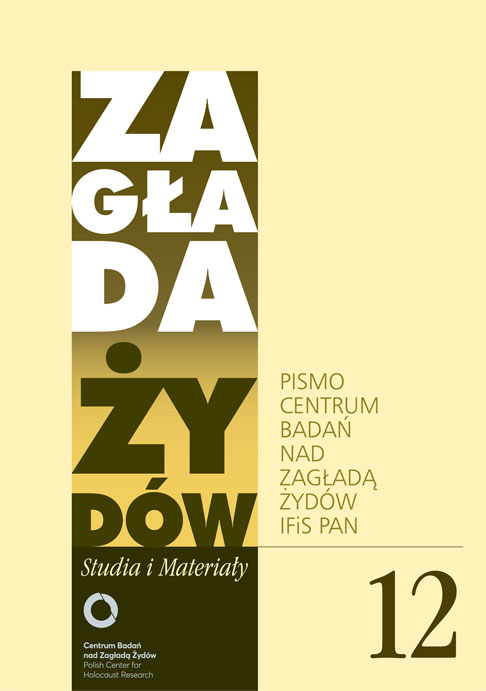Kindertransporty – brytyjskie akcje ratowania żydowskich dzieci w latach 1938–1939
Zagłada Żydów. Studia i Materiały, Nr 12 (2016), Strony: 141-168
Data zgłoszenia: 2020-10-19Data publikacji: 2016-11-30
 https://doi.org/10.32927/ZZSiM.412
https://doi.org/10.32927/ZZSiM.412
Abstrakt
The article talks about Kindertransports – the major rescue action organized by British-Jewish organizations, and run from the territory of Great Britain between 1938 and 1939. The Kindertransports aimed at gathering and sending to Great Britain Jewish children under the age of seventeen, in order to prevent them from witnessing, or being victims of the acts of violence in Nazi controlled Europe. Once in Great Britain, the children were supposed to spend several weeks with British families willing to give them shelter and support. Those for whom foster parents would not be found, were to be sent to boarding schools or temporary shelters. In the action’s planning phase the institutions involved considered the Kindertransports to be a temporary solution. As the situation of the Jewish population in Nazi controlled Europe worsened, it became clear that the character of the action needed to be revised, and the families were expected to guest the children for a longer and unspecified time. In the end approximately 10.000 Jewish children, who travelled to the Isles, were allowed to stay throughout the times of war. In 1945 it became clear that vast majority of them had no place or family to get back to. They stayed in Great Britain becoming an important and vital part of the British society, with British citizenships granted shortly after the end of the war. The article discusses the organization of the Kindertransport and talks about other solutions taken under consideration both by the program organizers, and the British government. It elaborates on the experiences the children shared, that is being separated from their families, feeling homesick, or finding oneself in the new environment. It explains the question of the lost identity of the participants of the program and speaks on how the subjects dealt with it. It also shows how the British legislature and laws connected to the Enemy Alien status together with the Defence Regulation 18B influenced lives of the underage survivors. The article ends with an attempt of estimation of what happened to the Kindertransport children after the war. How many of them remained in Great Britain and considered themselves British, how many shown high level of mobility and spend their lives changing their place of residence. In the end how many of them kept their self-identification as Jews, and how many converted.
Słowa kluczowe
Kindertransporty , Zagłada , Wielka Brytania , Trzecia Rzesza , akcja pomocowa , ratowanie , dzieci , ocaleni , Żydzi
Licencja
Prawa autorskie (c) 2016 Autor&"Zagłada Żydów. Studia i Materiały"

Utwór dostępny jest na licencji Creative Commons Uznanie autorstwa 4.0 Międzynarodowe.
https://creativecommons.org/licenses/by/4.0
Czasopismo publikowane jest w standardzie Diamond Open Access na licencji CC-BY-4.0 Deed - Uznanie autorstwa 4.0 Międzynarodowa - Creative Commons
Podobne artykuły
- Dariusz Libionka, Jacek Leociak, 75. rocznica akcji „Reinhardt” , Zagłada Żydów. Studia i Materiały: Nr 13 (2017)
- Małgorzata Melchior, Zagłada i stosunki polsko – żydowskie w opracowaniach socjologicznych. , Zagłada Żydów. Studia i Materiały: Nr 1 (2005)
- Katarzyna Odrzywołek, Piotr Trojański, Dzieci Teheranu – od mrozów Syberii do słońca Palestyny. Rola delegatur Ambasady RP w ZSRR i Armii gen. Andersa w ratowaniu dzieci żydowskich , Zagłada Żydów. Studia i Materiały: Nr 11 (2015)
- Nechama Tec, Małgorzata Melchior, O pomocy, o ratowaniu Żydów i o badaniu Zagłady – z profesor Nechamą Tec rozmawia Małgorzata Melchior , Zagłada Żydów. Studia i Materiały: Nr 4 (2008)
- Karolina Panz, Małgorzata Melchior, Nechama Tec , Zagłada Żydów. Studia i Materiały: Nr 19 (2023)
- Jacek Leociak, Redakcja Czasopisma, Dyskurs o pomocy , Zagłada Żydów. Studia i Materiały: Nr 4 (2008)
- Stephan Lehnstaedt, Akcja „Reinhardt” w świetle najnowszej niemieckiej literatury przedmiotu , Zagłada Żydów. Studia i Materiały: Nr 13 (2017)
- Danijel Matijevic, Jan Kwiatkowski, Krzesiny i Kreising – między pamiętaniem a pomijaniem. Polskie miasteczko wobec historii, pamięci i rywalizacji w cierpieniu , Zagłada Żydów. Studia i Materiały: Nr 10 (2014)
- Janusz Salamon, SJ, Dialog chrześcijańsko-żydowski w krainie schorowanej wyobraźni. Na marginesie książki Waldemara Chrostowskiego Kościół, Żydzi, Polska , Zagłada Żydów. Studia i Materiały: Nr 5 (2009)
- Janusz Salamon, SJ, Christian-Jewish Dialogue in the Land of Sick Imagination. On the Margins of Waldemar Chrostowski’s Book Kościół, Żydzi, Polska , Zagłada Żydów. Studia i Materiały: 2010: Holocaust Studies and Materials
1 2 3 4 5 6 7 8 9 10 11 12 13 14 15 16 17 18 19 20 21 22 23 24 25 26 27 28 29 30 31 32 33 34 35 36 37 38 39 40 41 42 43 44 45 46 47 48 49 50 > >>
Możesz również Rozpocznij zaawansowane wyszukiwanie podobieństw dla tego artykułu.
 English
English
 Język Polski
Język Polski



 https://orcid.org/0000-0003-0053-6000
https://orcid.org/0000-0003-0053-6000





